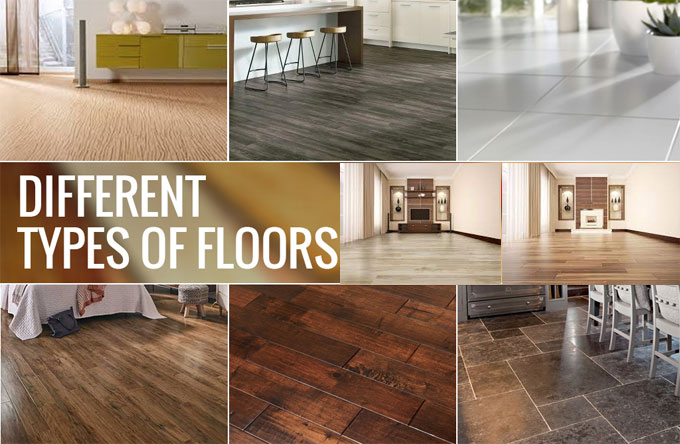
What are the various types of floors?

A floor can be defined as the bottom surface of a room or vehicle. Flooring is the general term used to define a permanent covering of a floor, or even for the process of installing a floor covering.
There are a variety in flooring that exists, different types of flooring exist as it the first thing one notices when they enter a house as it covers both the length and breadth of the house. The floor is also the surface which receives damage due to wear and tear caused by usage. Therefore, choosing the right kind of material is extremely important.
Types of Floors
The major types of Floors are as follows:
Mud Floor
Earthen flooring commonly also knows as Adobe flooring is made of dirt, raw earth along with other unworked ground materials. In current times it is constructed using mixture of sand, clay and finely chopped straw. In villages mud flooring is commonly constructed as by using stabilizers the soil properties can be enhanced with manipulation of its composition. The tensile and shear strength of the soil can be increased and the shrinkage is reduced.
Suitability- Mud floors are used in residential buildings particularly in rural areas where the easiest and cheapest option is preferred. Mud floors are not used in commercial or professional buildings. Mud floors are easy to maintain, it remains warm in winter and cold in summer and is therefore suitable for places where temperatures reach an extreme during these seasons.
Brick Floor
Brick flooring is a type of flooring where the floor is topped with bricks. This kind of flooring is easy to construct and repair but the surface is not smooth. The rough surface also easily absorbs and holds on to moisture which results in dampness in the building.
To construct a brick floor, the top surface of the earth or murram filing is made perfectly strong. A layer of clean sand about 10cm thick is spread evenly on the compacted earth. After which a layer of lime concrete (1:4:8) or lean cement concrete (1:4:16) is laid, compacted and cured. On this base concrete well soaked bricks are laid in cement mortar (1:4) in a suitable bond. In case of pointing, the joints must have minimum thickness of 2mm and the mortar must be struck off with a trowel in the joints. During the pointing, the minimum thickness of joints is to be kept at 6mm and the pointing may be done.
Suitability: This kind of floors are suitable for stores, storage places etc.
Tile Floor
Tile floor is the floor which is topped with tiles. The tiles used can be of any chosen quality, color, shape or thickness.
To construct a tile floor, the base course is made to prepare in the same way that brick flooring is prepared. On the base course prepared, a thin layer of lime or cement mortar is spread using screed battens. After which the screeds are properly leveled and fixed at the correct height. Upon the hardening of surface mortar, the chosen tiles are laid on a 6mm thick bed of wet cement mortar (1:5). The excess mortar comes out of the joints which is then cleaned off. The joints are well rubbed with carborundum stone after three days to smoothen the surface, specifically the edges.
Suitability: Such floorings are used for paving courtyard of buildings. Often glazed tiles floors are demanded for high-class building floors.
Flagstone Floor
The floors whose topping is made of stone slabs is called flagstone floor. Even though the stone slabs used here might not be of the same size but it must not be more than 75cm length and not less than 35cm in width and 3.8cm in thickness.
To construct a flagstone floor the method of tile floor is applied. The slabs are soaked well in water for a minimum of one hour before laying it for flooring. They must be evenly and firmly bedded in mortar. Thick joint thickness should not exceed 4mm and they should also be struck off with trowel while laying.
Suitability: Such flooring is suitable for go-downs, motor sheds, stores, pavements, etc.
Cement Concrete Floor
Concrete floor or conglomerate floor is the flooring where cement concrete is used for topping. The floors consist of 2.5cm to 5cm thick concrete layer laid over 10cm thick base of concrete and 10cm thick clean sand over ground which is compacted and consolidated. In modern times this kind of flooring is used.
Listed below are the advantages of cement concrete floor:
1. Hard and durable
2. They provide a smooth and non-absorbent surface.
3. A more sanitary surface is provided as they can be cleaned and washed easily.
4. They are also fire resistant.
5. They require negligible maintenance cost which makes them economical.
6. A pleasing appearance can be found when finished.
Types of Concrete Floor:
1. Non-monolithic or bonded floor finish floor
2. Monolithic floor finish floor.


